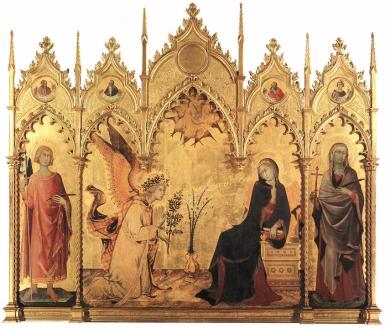
I have put off getting to grips with this topic for as long as possible, because it’s complicated, but the time has come to talk about the medieval New Year and why the English tax year begins on 6th April. It was not until I went to work in Germany that I realised that 6th April is an odd day for a tax year to begin. In Germany, and many other countries, it begins on 1st January. There is a reason why it begins on 6th April in England, but, as I said, it’s complicated.
Lady Day, or the Feast of the Annunciation (25th March), was the first day of the year in the Middle Ages. It was the celebration of the day on which the angel told Mary that she was pregnant, nine months before Christmas Day. Everything in the Middle Ages was based around the church calendar and 25th March was a sensible date to choose for the first day of the administrative year. You or I might have chosen the major feasts of Easter or Christmas, but Easter is a movable feast (in that its date changes from year to year), which makes it less than perfect as the beginning of the year. Christmas was such a big celebration that very little work was done. This made it less than suitable for a time requiring a lot of administrative work. The liturgical year began on the first day of Advent, which had much to recommend it, but that was also a date which changed from one year to the next. Lady Day was always on 25th March and was an important feast.
Lady Day and Christmas Day are two of the four quarter days. The others are Michaelmas, the feast of St Michael and all Angels on 29th September, and Midsummer, on 24th June. Contracts would usually run from one Lady Day to the next. In later centuries the quarter days were hiring days for labourers and the days on which rents were due. They were days of reckoning and debts had to be paid by the end of the quarter. The quarter days were important well into the twentieth century and some rents are still paid on quarter days.
Why does this mean that the English tax year begins on 6th April? This is where things get complicated. In the Middle Ages England used the Julian calendar, which came into use in 45 BC. This calendar had a Leap Year every four years, which meant that, over time, important dates, such as the vernal equinox and the solstices, got out of synch with the reality. Every 128 years the calendar would get out by a day. In 1582 Pope Gregory XIII introduced the Gregorian calendar in which there is a Leap Year ninety-seven times in four centuries rather than a hundred. This means that it take more than 3,000 years before the calendar is a day out.
By the time the Gregorian calendar was implemented in England in 1752 there was an eleven-day disparity between the two calendars and 3rd to 13th September did not exist in that year. The calendar went from 2nd to 14th September.
This is why the beginning of the financial year in England is 6th April. It’s not a wholly satisfying solution, until you realise that a tax year has to be 365 (or 366) days. Having a tax year with only 354 days would have caused all kinds of difficulties and arguments.
In the same year that this was introduced 1st January became the official start of the calendar year in England. This had long been the practice in Scotland and other countries. This meant that neither 1751 nor 1752 was a full year in England. In 1751 the calendar year ran from 25th March to 31st December. In 1752 it was from 1st January to 31st December less the eleven days in September. In order for the tax year to be a whole year, it had to run from 25th March 1752 to 5th April 1753.
Sadly, I haven’t been able to discover why those particular eleven days in September were chosen to be deleted. If you know, I’d love to hear from you.


